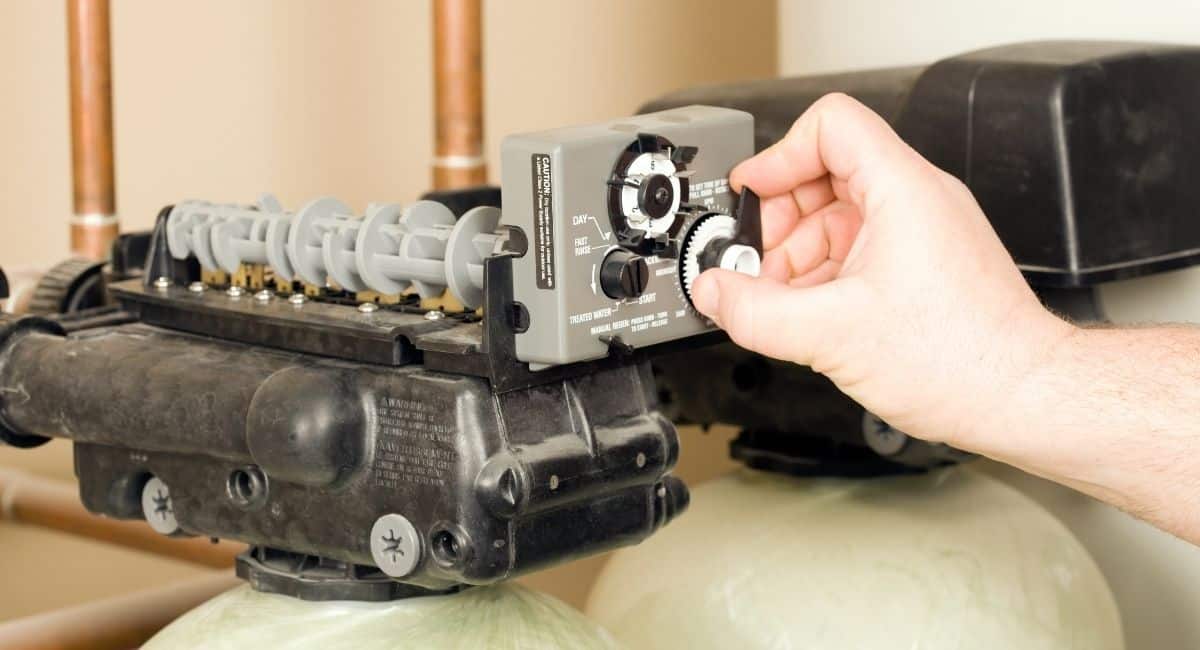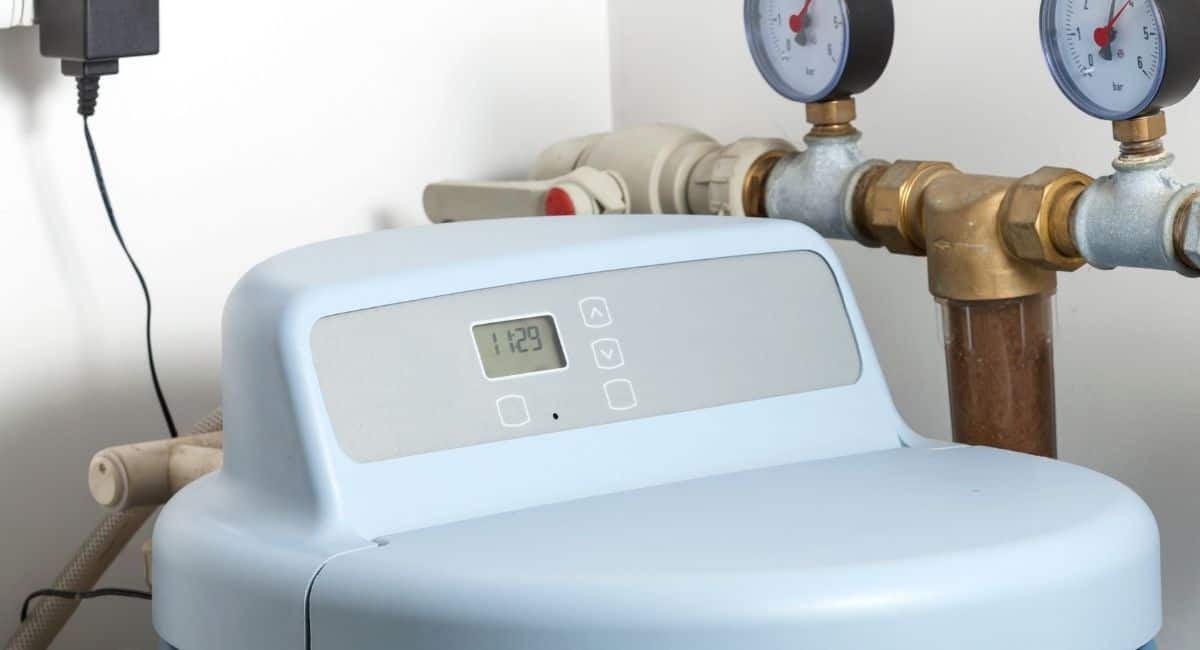We like to share product recommendations with you and hope you like them! Just to make you aware Water Filter Data may collect a small share of sales or other compensation from the links on this page.
If your water softener stops working after a power outage, don’t worry – you can still reset it!
In this blog post, we will walk you through the process of bypassing the recharge cycle and getting your water softener back up and running. We also answer some common questions about water softeners.
Keep in mind that water softeners may or may not need electricity to operate, depending upon the model.

Resetting a Water Softener
The first thing to do is locate your water softener’s bypass valve. If it has a battery backup, as many models do these days, then that should be easy enough – just check how high up from the floor it is and look around for any signs of rust or corrosion on nearby pipes or wires. You may also need a flashlight if it’s too dim nearby.
Once located, turn off all power sources at once before proceeding. Then, disconnect both ends from their respective connections using pliers: one end should come out quickly with little effort but make sure not to break anything delicate inside, such as an O-ring sealant.
The other end (the one that connects to the water supply) might be a little more complicated as it will likely have some pressure behind it. In this case, try using a wrench or even a hammer and screwdriver if need be; just make sure not to damage the pipe in the process!
Now turn on the faucet nearest your water softener until water starts flowing out – don’t worry, you’re not going to flood anything. Once clear, open up the bypass valve all the way by rotating it counter-clockwise with your fingers. If done correctly, this will now allow water to flow directly into and out of your softener without having to go through any of the filtration processes.
From here, you should be able to see how much salt is left in the brine tank (usually a translucent white). If it’s low and you don’t have any extra on hand, then it might be time for a refill – just make sure the power is back on and functioning correctly before doing so. Otherwise, close up the bypass valve by rotating it clockwise until it’s snug and turn on the power again. The water softener will now start going through its recharge cycle automatically.
If your water softener runs out of salt, there are a few things you can do as long as there is still some in the brine tank. You can try adding table salt or kosher salt, but it’s not recommended as they contain different levels of sodium. A better option is to purchase a bag or two of water softener salt from your local hardware store.
Does A Water Softener Remove All Limescale?
This depends upon how bad the limescale build-up is. If it’s only in a few spots, the water softener will most likely take care of it with each regeneration cycle. But if there is significant build-up throughout the entire system, it might be time to do manual cleaning.
Do Water Softeners Need Electricity?
Most water softeners do not need electricity to operate, though some models may require it for certain features such as salt-less operation. This could include salt sensors or other types of monitoring devices that monitor salt usage and determine when more needs to be added.
If your model requires power, then it will typically come from either an AC (Alternating Current) outlet (in which case you can plug it into any wall socket) or a battery backup system charged by solar panels on top of the unit itself. The former option might be preferable if there aren’t many available outlets near where you’ll place your softener; both work just fine.
For salt-less operation, the salt sensors need electricity to function correctly, monitor salt usage, and determine when more needs to be added. The batteries that come with these units last about five years before needing replacement. If you’re using a salt-less system, this may not be necessary since there aren’t any salt crystals involved.

Should Water Softeners Be Full Of Water?
It depends on what type of salt you’re using and how much salt is already in your water softener. If it’s salt pellets or granular salt, then yes – the tank should always be full with no air pockets because these types absorb moisture when they dissolve (which can cause corrosion if there isn’t enough salt left).
If it’s potassium chloride powder instead, then no. Since this doesn’t absorb any liquid whatsoever, there’s less risk of damage to internal components due to lack of lubrication.
The best way to determine whether or not your water softener is full of salt when using either product would be by checking its manual for instructions on maintaining proper levels based on usage frequency/amounts needed per day etc., and then filling it to that specific level. You should also keep an eye on the brine tank and refill it when necessary.
If you’re using a water softener that doesn’t require electricity, then there is no need to worry about filling it up with salt as long as there is some left in the brine tank. If your model needs power, you will want to make sure it’s always full of pellets or granular salt so it can adequately absorb moisture and dissolve.
Do not let the level get too low, otherwise you might experience problems like corrosion or lack of lubrication down the line.
- When filling your tank, make sure there aren’t any air pockets because these types of particles absorb moisture when they dissolve (which can cause corrosion if there isn’t enough salt left). Always consult your owner’s manual for more specific instructions about maintaining proper levels based on usage frequency/amounts needed per day.
- If your water softener doesn’t require electricity, then there is no need to worry about filling the tank with salt. If it does need power, make sure it’s always full of pellets or granular salt to absorb moisture and dissolve properly
What if Power Outage Happens During Recharge Cycle?
If a power outage happens while your water softener is in the recharge cycle, it will stop, and you’ll need to reset it manually. To do this:
- Turn off the water supply to your softener by turning off the main valve on top of the unit or closest to where your water enters your home (this is usually under the sink)
- Open up the brine tank lid and remove any excess salt if needed
- Look for a small red button on the front panel of your machine – the recharging button
- Push and hold down this button for about five seconds until the light turns green; release when it does
- Your water softener is now in manual mode – turn the water back on and start the recharge cycle again by following the exact same instructions as before
Tips About Water Softeners to Keep Yours Running Smoothly
Your home’s water softener is a piece of equipment that must be maintained properly. Water softeners are pieces of equipment that help soften hard water by removing minerals such as calcium and magnesium, thus keeping your faucets shiny and free from residue build-up.
Hard water can also damage other appliances in the house, like washing machines, and dishwashers, besides causing dry skin for those who use them for showering purposes. Here are a few tips to help you keep your water softener running smoothly:
- Check the salt levels in the brine tank regularly and add salt as needed. If you do not have enough salt in the tank, it will not be able to function properly
- Clean the filters regularly. This can help keep your water softener running at peak performance
- Ensure that all of the valves are open and that there is proper drainage for the system. You don’t want any backed-up water ruining your landscaping or seeping into your home through cracks in your foundation
- If you find that your water softener isn’t working as well as it used to, try regenerating it manually
Conclusion
The last thing anyone wants is hard water or issues like corrosion or lack of lubrication down the line. Homeowners need to know how their water softeners work, how often they need salt refills or replacements (if applicable), and how to reset the water softener after a power outage.
Make sure your system stays up-to-date by following these tips from experts in the field!



